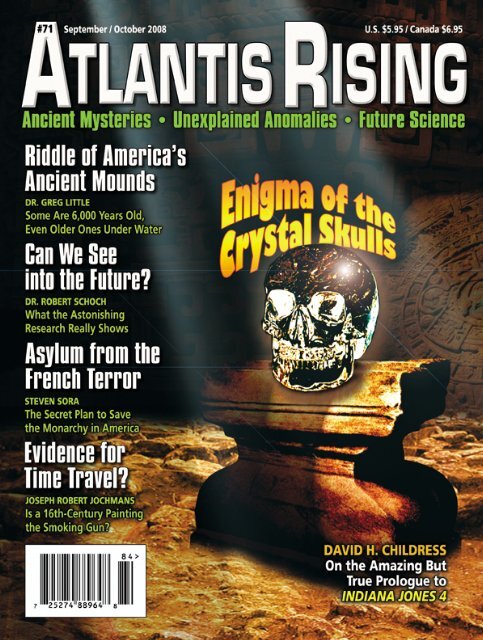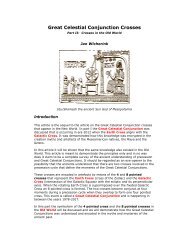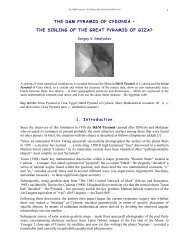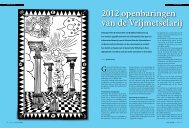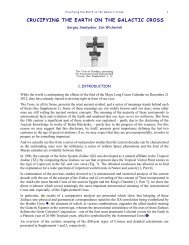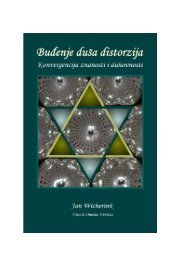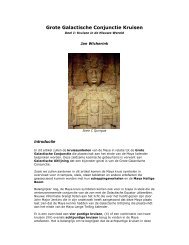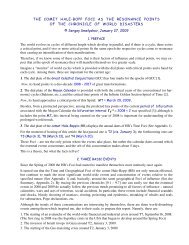Get a FREE Sampler PDF - Atlantis Rising Magazine
Get a FREE Sampler PDF - Atlantis Rising Magazine
Get a FREE Sampler PDF - Atlantis Rising Magazine
Create successful ePaper yourself
Turn your PDF publications into a flip-book with our unique Google optimized e-Paper software.
44 ATLANTIS RISING • Number 58 Subscribe or Order Books, Videos and Much More!
See Our Great 8-page Catalog Beginning on Page 74 Number 58 • ATLANTIS RISING 3
EARLY RAYS<br />
GENETIC MATERIAL<br />
CAME FROM SPACE<br />
W<br />
hen ancient meteorites rained down on<br />
earth they brought more than fire and<br />
rocks from the sky. They brought the raw genetic<br />
material for life. That, at least, is the<br />
conclusion of scientific researchers from Europe<br />
and the USA.<br />
Freshly published in the journal Earth<br />
and Planetary Science Letters, the new study<br />
is based on a careful study of the Murchison<br />
meteorite which crashed in Australia in 1969.<br />
In its materials scientists found the molecules<br />
uracil and xanthine which are precursors<br />
to the molecules that make up DNA and<br />
RNA. After ruling out that they could have<br />
come from earth, the study says they came<br />
from space, and that means, it says, that life<br />
on earth is extraterrestrial in origin.<br />
Conventional science holds that about<br />
four billion years ago meteors like the Murchison<br />
rained down on earth just when primitive<br />
life was getting started. Lead author Dr<br />
Zita Martins, of the Department of Earth Science<br />
and Engineering at Imperial College<br />
London, says that the research may provide<br />
another piece of evidence explaining the evolution<br />
of early life. “We believe early life,” she<br />
says, “may have adopted nucleobases from<br />
meteoritic fragments for use in genetic<br />
coding which enabled them to pass on their<br />
successful features to subsequent generations.”<br />
The new research buttresses the argument<br />
of those who believe in panspermia, the<br />
notion that seeds of life exist already all over<br />
the universe, and that life on earth originated<br />
through these seeds, and that they may deliver<br />
or have delivered life to other equally<br />
hospitable planets.<br />
So, if life on earth started somewhere<br />
else, just how did it get started there?<br />
Whether here or there, science still has a lot<br />
of explaining to do.<br />
Water Ice Is on Mars<br />
W<br />
hile the matter of whether there is, or ever has been, life on<br />
Mars is still—insofar as NASA is concerned—unsettled, at least<br />
one question has now been answered definitively. There actually is<br />
frozen water on Mars.<br />
As millions on earth watched over television and the Internet, the<br />
Mars Phoenix Lander settled softly on the Martian surface, near the<br />
North pole on May 25 and despite considerable suspense, everything<br />
went smoothly. This was the first time in 30 years that a rocketassisted<br />
soft landing had succeeded. The mission: to determine if<br />
there has ever been liquid water on Mars. The presence of such water<br />
is believed to be essential to life; after all, it is on warth. First,<br />
though, it was necessary to establish that the Lander was actually positioned<br />
over ice.<br />
Photos beamed back to earth showed some kind of white substance<br />
just beneath the dirt scraped away by the Lander’s scoop. But<br />
at first, it was impossible to say whether they were looking at ice or<br />
some kind of salt. Over the next few days though, as chunks of the<br />
white stuff slowly disappeared, NASA scientists became convinced<br />
that it was indeed ice which could melt and not something else.<br />
The next step is to analyze the ice and the water obtained by<br />
melting, which will, hopefully, answer many more burning questions<br />
about the status of life on Mars, both then and now.<br />
To be continued.<br />
Images from NASA’s Phoenix Lander on June 15 (left) and 19 show<br />
10 ATLANTIS RISING • Number 71<br />
sublimation of Subscribe ice. (NASA or Order and University Books, DVDs of Arizona) and Much More!
THE SPACE<br />
ARCHAEOLOGISTS<br />
T<br />
NASA’s Aster satellite images EGYPT in 15 different wavelengths. The data<br />
is processed so that fields are red, cities blue and ancient ruins are green.<br />
(Photo: NASA/JPL/University of Sydney)<br />
he advances of civilization have been<br />
compared to climbing a mountain. As we<br />
reach new heights, we are able for the first<br />
time to see the long path we have travelled<br />
stretched out beneath us, and with the advantage<br />
of altitude we can see where we have<br />
gone right and where we have gone wrong.<br />
Moreover, we can see patterns in our<br />
progress of which we might have been unaware<br />
at the time we passed through. While<br />
that notion may seen to be strictly metaphorical,<br />
a new breed of archaeologist is literally<br />
taking the concept to new heights these<br />
days...like to outer space.<br />
According to popsci.com the web site of<br />
Popular Science <strong>Magazine</strong>, the new archaeologists<br />
are carrying out their researches<br />
without getting their hands dirty, learning<br />
more from above the atmosphere than from<br />
the bottom of any dig. In a piece called<br />
“Space Archaeologists” writer Mara Hvistendahl<br />
details the work of Damian Evans and<br />
Bill Saturno who, with the help of radar im-<br />
orkers in Pretoria, South<br />
Africa, have unearthed<br />
stone tools said to date back<br />
100,000 years. The artifacts<br />
turned up in a swimming pool<br />
excavation and included a<br />
number of flaked cutting tools<br />
believed to have been used to extract<br />
marrow from bones. There<br />
was also a stone which had been<br />
brought in from another area,<br />
considered an unmistakable sign<br />
of human activity.<br />
Dr. Francis Thackeray, director<br />
of the Transvaal Museum,<br />
aging satellites, have uncovered many previously<br />
undiscovered details to Cambodia’s<br />
great temple complex at Angkor Wat. Thanks<br />
to such techniques scientists are unearthing<br />
whole civilizations and rewriting history<br />
books. In issue #70 of A.R., Frank Joseph<br />
told of how satellite imagery was used to locate<br />
Ubar, a.k.a. “The <strong>Atlantis</strong> of the Sands,”<br />
on the Arabian peninsula. Similar stories are<br />
coming from Mexico, South America and<br />
every corner of the world.<br />
For many readers of this magazine, eager<br />
for the discovery of a lost prediluvian civilization,<br />
such research appears very promising<br />
indeed. The ability to see what lies beneath<br />
the oceans is constantly improving. For<br />
those who would like to see some of the remarkable<br />
anomalies that are, at last, rising<br />
to the surface, visit the web site satellitediscoveries.com<br />
where publicly released satellite<br />
imagery reveals many remarkable and<br />
previously unrecognized features of our<br />
planet.<br />
100,000-Year-Old Tools Found<br />
W<br />
Bones in<br />
Sterkfontein<br />
Cave<br />
told reporters visiting the site<br />
that the tools were similar to<br />
ones he himself had turned up<br />
at other sites such as Kromdraai<br />
in the Sterkfontein valley, the<br />
region which, according to conventional<br />
anthropology, is the<br />
cradle of humanity.<br />
For another take on the artifacts<br />
from Sterkfontein cave see<br />
Michael Cremo’s Forbidden<br />
Archaeologist column in A.R.<br />
#59, “Sterkfontein: Cradle of<br />
Humanity or of Lies?”<br />
See Our Great 8-page Catalog Beginning on Page 74<br />
Number 71 • ATLANTIS RISING 11
REPORT FROM THE FRONT<br />
Tracking the News of the Coming Energy Revolution<br />
I<br />
BY<br />
JEANE<br />
MANNING<br />
n the 1967 film The Graduate, at a party<br />
an industrialist takes the college-grad<br />
character aside and indicates he has a secret<br />
to impart as his graduation gift. The audience<br />
knows the young man has not yet settled<br />
on a career direction. The middle-aged<br />
man whispers one word of advice. “Plastics.”<br />
That scene was enjoyed as a classic comic<br />
moment, heightened by the rebellious antiestablishment<br />
mood of many in the 1960s<br />
audiences. The youthful character played by<br />
Dustin Hoffman was confused, but not about<br />
to devote his life to plastics no matter how<br />
exponentially that industry would grow.<br />
More than forty years later, the ultimate<br />
word for career advice could be “water.” Unlike<br />
the plastic garbage being ground into<br />
nano-particles while plastics weather on<br />
beaches and in landfills, when water breaks<br />
down, its components are harmless to life.<br />
Oxygen is better than harmless; it sustains<br />
life. Hydrogen is a carrier of energy and is<br />
being considered as a vital part of the<br />
coming energy revolution and one key to reducing<br />
our dependence on carbon fuels such<br />
as gasoline.<br />
Water is the film star of Youtube videos<br />
today. Recently one video featured what was<br />
said to be a 1978 El Camino vehicle that<br />
runs on water alone. Someone who at this<br />
time remains anonymous and uses a pseudonym<br />
online had developed what is being<br />
called the “S1r9a9m9 exploding water<br />
system,” and there’s a link to another Youtube<br />
video of a car running on an independent<br />
replication of that system. By the time<br />
this column is published there will no doubt<br />
be further news developments. I’m just<br />
trying to convey the rapid progress of this<br />
emerging area of guerrilla science and of energy<br />
independence.<br />
Unlike the mid-twentieth-century culture<br />
of industrial secrets and social-climbing pool<br />
parties glimpsed in The Graduate, the<br />
twenty-first-century Open Source era is, for<br />
many young people, about sharing information.<br />
However, as in the case of the mysterious<br />
inventor of the water system, open<br />
sourcing does not always mean stepping into<br />
the spotlight as a public personality.<br />
Taking a cue from the computer software<br />
developers who write programs and give<br />
their work to everyone else to tweak and perfect,<br />
a number of inventors on the energy<br />
frontier are freely sharing what they learn.<br />
George Wiseman of Eagle Research pioneered<br />
that approach by writing how-to<br />
books about methods of saving fuel. Instead<br />
Could the Wave of the Future Be in Water?<br />
Brown’s gas generator<br />
of patenting his inventions he sells books.<br />
His readers try out his advice and reply to<br />
him. Their experiences and suggestions improve<br />
the next editions of Wiseman’s books.<br />
His no-patent philosophy is a win-win approach.<br />
Wiseman wrote two editions of a<br />
Brown's Gas Book, which contain some of<br />
the most important contributions to the<br />
field, with research data, practical analysis<br />
and discussions of the implications of the<br />
technologies.<br />
Up until recent years experimenters<br />
around the world used the term “Brown’s<br />
Gas,” but that term is rarely used any more<br />
to describe an oxy-hydrogen gas. The Bulgarian/Australian<br />
inventor Yull Brown is no<br />
longer with us and there is widespread recognition<br />
that a physicist named William A.<br />
Rhodes discovered the process for making<br />
and using atomic (in the form of separate<br />
atoms and no longer combined in molecules)<br />
hydrogen and oxygen before Brown<br />
did. Welding torches are one of the most apt<br />
applications for the gas.<br />
their activities are most apparent in the<br />
water-as-fuel areas of the energy frontier. For<br />
instance, the experimenter who developed an<br />
“exploding water system” under the name<br />
“S1r9a9m9” is part of the ongoing discussion<br />
on a Yahoo web site e-group. When he builds<br />
an experimental model he eventually publishes<br />
the new parts list of electronics so that<br />
anyone in the discussion group can try<br />
building it themselves.<br />
“Yes, it is an exciting time to be alive,” an<br />
energy researcher writes to me in an email<br />
today. “John Bedini just posted advice to the<br />
JBCX6 S1r9a9m9 replicator guy…I am seriously<br />
thinking this system is the big break. It<br />
is so cheap and easy for the common person<br />
to replicate once we get all the bugs out (and<br />
have a list of the parts needed).”<br />
Charles Michael Couch had been writing<br />
articles on the Pure Energy Systems network<br />
about inventor Bob Boyce, who gives the<br />
world free benefit of his own super-efficient<br />
water-into-fuel electrolyzer system. Couch<br />
said he was now thankful to have seen the<br />
video of a replication of the “S1r9a9m9”<br />
system and was grateful that now both systems<br />
are available to experimenters around<br />
the world, along with John Bedini’s motor, a<br />
Good news for all<br />
The pain of paying high prices for fuel is<br />
motivating a fast-increasing number of tinkerers<br />
who had not previously been obsessed<br />
about energy alternatives, and the results of Continued on Page 58<br />
See Our Great 8-page Catalog Beginning on Page 74 Number 71 • ATLANTIS RISING 17
OUT-OF-PLACE ARTIFACTS<br />
TIME TRAVEL EVIDENCE<br />
Does a 16th-Century Painting Show Technology from the Future?<br />
O • BY JOSEPH ROBERT JOCHMANS<br />
ur world is filled with many anomalies,<br />
most of them well documented<br />
and incontrovertible, which demonstrate<br />
that space and time are not<br />
what we think they are. One of the strangest<br />
of these is an enigmatic object which appears<br />
in a painting in the little church of Montalcino<br />
in Italy, dating to over four hundred<br />
years old. The object can be classified as a<br />
genuine “out-of-place” artifact, because it incorporates<br />
several apparently advanced aspects<br />
in its design.<br />
But the context in which it was placed in<br />
the painting and portrayed in detail opens up<br />
a whole different level of technological inquiry<br />
and potential achievement. The item’s<br />
existence raises not only the question of<br />
where did it come from, but more importantly,<br />
when did it come from? For here we<br />
are faced with something that is more than<br />
out of place, it also appears to have come<br />
from a totally different time.<br />
In essence, what we may be looking at<br />
could be the first real evidence for time<br />
travel.<br />
At this point, we cannot be sure if the<br />
item in question manifested from our future<br />
or if it represents some kind of time-traveling<br />
technology, which was the product of the unknown<br />
past, built and sent forward to our period<br />
from some prehistoric civilization now<br />
lost to us. Let the readers judge for themselves.<br />
In 1595, Italian artist Bonaventura Salimbeni<br />
(1567-1613) was commissioned to produce<br />
a painting for the right-hand altar of the<br />
Church of St. Peter at Montalcino, located<br />
within a few miles of Florence. He was a<br />
member of a prominent family of artists from<br />
nearby Siena, and the goal of his commission<br />
was that his work be completed for the Christian<br />
Jubilee Year of 1600. According to the<br />
message accompanying his signature, Salimbeni’s<br />
painting was finished right on<br />
schedule.<br />
The Montalcino art masterpiece is entitled<br />
“The Glorification of the Eucharist,” and<br />
features a vertical work divided into three<br />
segments. The lower third depicts a number<br />
of worshipping figures seated before the<br />
altar, including priests, cardinals and one individual<br />
wearing a papal crown believed to<br />
represent Pope Clement VII.<br />
The middle third shows the altar itself,<br />
and prominently displayed in its center is the<br />
Cup of the Eucharist emblazoned in glowing<br />
light.<br />
The upper third of the painting symbol-<br />
izes heaven, dominated by the three Beings<br />
of the Holy Trinity who are looking down on<br />
the earthly scene below and giving their<br />
blessings—God the Father depicted as a<br />
Moses-like bearded old man, God the Son as<br />
Jesus Christ, and the Holy Spirit portrayed<br />
as a Dove hovering above the center.<br />
What immediately catches the viewer’s<br />
attention, however, is something pictured in<br />
among the Trinity members that to modern<br />
eyes seems very familiar, but not from the<br />
right time period. The first impression is<br />
that it looks exactly like a spheroid satellite<br />
with two antennae, something akin to the<br />
old Russian sputniks or American vanguard<br />
orbiters of the late 1950s. But what is it actually<br />
supposed to be?<br />
Renaissance art experts interpret the<br />
strange sphere as representing the universe,<br />
showing the faint lines of celestial longitude<br />
and latitude, plus the images of an obscure<br />
sun and an exaggerated crescent moon<br />
Continued on Page 62<br />
See Our Great 8-page Catalog Beginning on Page 74 Number 71 • ATLANTIS RISING 29
ANCIENT MYSTERIES<br />
• BY JAN WICHERINK<br />
The inscription on William Sinclair’s<br />
grave in Rosslyn Chapel reads: William<br />
de St. Clair, Knight Templar.<br />
On his gravestone a mysterious key<br />
with an eight-pointed cross is depicted. The<br />
official coat of arms of the Sinclair’s is a<br />
four-pointed cross in a stitch pattern, and<br />
it’s well known that the Knights Templar<br />
used both four- and eight-pointed crosses in<br />
their coat of arms. So the question is: what<br />
does this key on William Sinclairs grave<br />
represent? Could this key possibly unlock<br />
some of the mysteries surrounding the<br />
chapel?<br />
In this article I will argue that these<br />
four- and eight-pointed crosses have a deep<br />
esoteric and astronomical significance that<br />
must have been well known to the Scottish<br />
freemasons.<br />
On the gravestone besides the eightpointed<br />
cross a four-pointed cross is also depicted.<br />
The name of the founder of Rosslyn<br />
Chapel is spelled in Lombardic letters<br />
‘Willhm de Sinncler’. It’s remarkable that<br />
the last two letters ER are set apart and are<br />
reversed in spelling. It reads RE. RE most<br />
likely is a reference to Amen-Re or Amen-<br />
Ra, the Egyptian solar deity. This makes<br />
sense since Rosslyn Chapel is in fact a solar<br />
temple. Inaugurated on the fall equinox in<br />
1450 as the Collegiate Church of St. Matthew,<br />
the chapel is perfectly aligned to the<br />
cardinal points of the compass in a manner<br />
Templar Crosses<br />
Gravestone of William Sinclair with an<br />
eight pointed cross<br />
Depiction on the gravestone of William Sinclair,<br />
founder of the chapel.<br />
similar to many ancient solar temples.<br />
In fact, according to Robert Lomas and<br />
Christopher Knight, Rosslyn is actually a<br />
copy of Solomon’s Temple in Jerusalem.<br />
They argue that the Master and Apprentice<br />
Pillar correspond with the two pillars, Boaz<br />
and Jachin, that stood in front of Solomon’s<br />
Temple.<br />
In The Stone Puzzle of Rosslyn Chapel<br />
Philip Coppens describes the initiation rituals<br />
of the freemasons and claims that the<br />
famous pillars in Rosslyn, in fact, correspond<br />
with the three degrees in freemasonry.<br />
In Masonic initiation rituals the pillars<br />
mark the solstices and equinoxes, the<br />
four quadrants of the year. The novice initiated<br />
into the “Entered Apprentice” degree<br />
is placed in the Lodge near the pillar in the<br />
northeast corner (Jachin). This pillar corresponds<br />
to the summer solstice. A freemason<br />
initiated into the “Fellow craft Mason” degree<br />
is placed in the southeast corner (Boaz)<br />
corresponding to the winter solstice. A freemason<br />
who is finally initiated into the<br />
Master Mason degree is placed in front of<br />
the central pillar corresponding to the<br />
equinox. During the latter ritual the candidate<br />
dies, symbolically, but is eventually resurrected.<br />
At the moment of his resurrection,<br />
a light with a five-pointed star is lit. According<br />
to Coppens, this five-pointed star is<br />
the morning star, Venus.<br />
These Masonic rituals clearly refer to the<br />
annual death and ‘rebirth’ of the sun. The<br />
sun dies each year on the cross of the zodiac<br />
on the winter solstice, only to be fully reborn<br />
on the following vernal equinox, the<br />
beginning of spring, in the annual cycle. At<br />
this point the sun is fully raised from death<br />
and, as it revives, nature starts to blossom<br />
Continued on Page 66<br />
38 ATLANTIS RISING • Number 71 Subscribe or Order Books, DVDs and Much More!
ALTERNATIVE SCIENCE<br />
Can We<br />
See into<br />
the Future?<br />
A Scientist Looks<br />
for Evidence<br />
of Precognition<br />
• BY ROBERT SCHOCH, Ph.D.<br />
O<br />
n 21 October, 1966, at 9:15 in the<br />
morning, a huge pile of coal slag<br />
and debris, precariously perched on<br />
the side of a mountain and destabilized<br />
by underground water and rainfall,<br />
came crashing down on the Welsh town of<br />
Aberfan. When the tragedy was over and the<br />
final death toll computed, 144 lives were lost,<br />
most of them children attending the Pantglas<br />
Junior School, upon which the main<br />
part of the avalanche of black choking slurry<br />
descended. The Aberfan disaster was felt<br />
throughout Britain, perhaps among some<br />
people even before it actually occurred.<br />
Dr. J. C. Barker, a psychiatrist associated<br />
with Shelton Hospital in Shrewsbury, was on<br />
the scene of Aberfan the next day to help<br />
with the aftermath. Dr. Barker was also interested<br />
in psychical research, and it occurred<br />
to him that, given the violent and shocking<br />
nature of the Aberfan disaster, perhaps<br />
someone had had a premonition of the event.<br />
He made a public appeal for any such information<br />
through the media, and as a result received<br />
dozens and dozens of responses from<br />
people who claimed to have had precognitive<br />
experiences that, at least in hindsight, may<br />
have related to Aberfan. Dr. Barker carefully<br />
researched the best of these through interviews<br />
and seeking out corroborative evidence,<br />
and found nearly two dozen reputed<br />
precognitive experiences that could be independently<br />
confirmed by witnesses as having<br />
occurred before the Aberfan disaster.<br />
As an example of just one such person<br />
with apparent precognitive knowledge of the<br />
event we can cite Mrs. Constance Miller who<br />
“saw” the disaster about a day or so before it<br />
happened. Seven witnesses could testify that<br />
Mrs. Miller had related her premonition to<br />
them before the event. In her own words<br />
(quoted in Archie Roy, A Sense of Something<br />
Strange, 1990, p. 129), “First, I ‘saw’ an old<br />
school house nestling in a valley, then a<br />
Welsh miner, then an avalanche of coal hurtling<br />
down a mountainside. At the bottom of<br />
this mountain of hurtling coal was a little<br />
boy with a long fringe looking absolutely terrified<br />
to death. Then for a while I ‘saw’<br />
rescue operations taking place. I had an impression<br />
that the little boy was left behind<br />
and saved. He looked so grief-stricken. I<br />
could never forget him, and also with him<br />
was one of the rescue workers wearing an<br />
unusual peaked cap.” Mrs. Miller was not<br />
from Aberfan, and the argument that she<br />
had a personal interest in, and subconscious<br />
worries about, the slag pile as a potential<br />
threat does not apply. Very importantly, as<br />
we will discuss below, Mrs. Miller reported<br />
that, after the event, she recognized on a television<br />
program covering the Aberfan disaster<br />
the little boy and the rescue worker she<br />
“saw” so vividly in her premonition.<br />
For thousands of years, going back to the<br />
Biblical prophets and the classical oracles of<br />
ancient times (and probably much earlier)<br />
there has been a belief that at least some<br />
gifted people can gain glimpses of the future.<br />
The Greeks regularly consulted their oracles,<br />
such as that of Apollo at Delphi, and all cultures<br />
seem to have their methods of divination,<br />
whether it be the inspection of the entrails<br />
of animals, gazing into a crystal ball,<br />
looking at patterns among tea leaves, or consulting<br />
the Tarot or I Ching.<br />
In the book of Genesis it is recorded that<br />
Art, after the manner of<br />
Kirlian photography<br />
Joseph correctly interpreted pharaoh’s precognitive<br />
dream (seven fat cows eaten by<br />
seven lean cows, meaning there would be<br />
seven good years of harvest followed by seven<br />
years of famine). Daniel, in the book named<br />
after him, interpreted King Nebuchadnezzar’s<br />
dream of a great image or statue and<br />
a tree hewn down to indicate that the king<br />
and his kingdom would be destroyed, as was<br />
the case. St. John, in what is commonly referred<br />
to as the Book of Revelation, or The<br />
Apocalypse, relates many prophecies that appear<br />
to refer to the End Times. The Four<br />
Horsemen of the Apocalypse, found in<br />
chapter 6, have household name recognition.<br />
Might these events yet unfold?<br />
Closer to our own times, perhaps the<br />
greatest (or at least most famous) seer of the<br />
last five centuries is Nostradamus (Michel de<br />
Nostredame, 1503-1566). Trained as an astrologer<br />
and physician (he was very successful<br />
at treating outbreaks of the plague in<br />
southern France), he was heavily steeped in<br />
Jewish mysticism. To this day admirers and<br />
detractors argue over the accuracy of his<br />
forecasts. It seems clear, however, that in his<br />
own lifetime Nostradamus had achieved a<br />
Continued on Page 67<br />
40 ATLANTIS RISING • Number 71 Subscribe or Order Books, DVDs and Much More!
ANCIENT MYSTERIES<br />
• BY DAVID H. CHILDRESS<br />
With the opening of the movie Indiana Jones and the<br />
Kingdom of the Crystal Skull, millions have been<br />
learning for the first time about one of the most remarkable<br />
stories in the annals of archaeology, the mystery of<br />
the crystal skulls. The movie may be fiction, but the tale of the crystal<br />
skulls is not only filled with plenty of Hollywood-style adventure, a<br />
lot of it is true.<br />
One of the most fascinating substances in nature, crystal lends itself<br />
uniquely to various adaptations, including information storage.<br />
Today crystal technologies are at the cutting edge of advancements in<br />
nanotechnology and computing. As for the skulls, themselves, does<br />
the fact that they are carved from crystal enable them to store information<br />
and interact with human thought waves? Strangely, there is<br />
evidence to suggest this could be so.<br />
Moreover, the history of Mesoamerica, where the skulls are said to<br />
originate, is rich with the mystical, magical sorcery of the Olmecs,<br />
Zapotecs, Maya and Aztecs. Indeed, the turbulent times of the Mexican<br />
Revolution form the backdrop for much of the most recent part<br />
of the tale, including the saga of F. A. Mitchell-Hedges, the notorious<br />
adventurer who emerged from the jungles, it was said, with the most<br />
famous of the crystal skulls—the so-called “Skull of Doom.”<br />
There are genuine enigmas associated with crystal skulls. Some<br />
seem outlandish, while others would appear to make sense but aren't<br />
necessarily true either. Studies of crystal skulls run from exacting scientific<br />
examinations to bizarre psychic readings that could never be<br />
proven. Much of the material on crystal skulls may be fabricated or<br />
deceptive, and the age and origins of the objects obscured—but one<br />
thing is certain: crystal skulls are real!<br />
The second most abundant mineral on the earth, after feldspar,<br />
quartz has even been found in meteors. It is a large component of<br />
sand and sandstone, and is part of almost every rock, be it igneous,<br />
metamorphic or sedimentary. It is the main mineral in most gemstones.<br />
Quartz is extremely hard rock, with a Mohs scale of 7. Since diamonds<br />
are one of the few minerals that exceed quartz in hardness, diamond-tipped<br />
tools or dust are thought to have been used to make<br />
most crystal skulls.<br />
Quartz has a lattice of “silica tetrahedra” and ideally forms into a<br />
six-sided prism terminating with six-sided pyramids at each end. Its<br />
crystals can grow together and become intertwined and therefore<br />
show only part of this shape, looking like a giant crystal mass. But<br />
the underlying crystalline structure, one in which internal patterns<br />
of molecules are regular, repeated and geometrically arranged, gives<br />
quartz many of its striking properties, and makes it possible for one<br />
to believe that crystal skulls may actually be the depositories of ancient<br />
wisdom.<br />
Eric Smalley, in an article about quantum computers in Technology<br />
Research News (online at trnmag.com) reports that a research<br />
team from the U.S. and Korea succeeded in storing a light<br />
pulse in a crystal, and then reconstituting it. This was significant because<br />
quantum information is notoriously fragile, and the ability to<br />
store it in a crystal would advance the feasibility of building a<br />
quantum computer (which would theoretically work at far faster<br />
speeds than are now possible).<br />
Although there is much work to be done to develop a quantum<br />
memory chip, experiments with crystal seem promising. More recent<br />
research takes the use of crystals in information processing a step<br />
further, experimenting with perhaps the ultimate material in information<br />
storage, DNA.<br />
According to Science Daily “Crystals promise a new way to process<br />
information.” An article in February, 2003 reported, “A team led<br />
by Richard Kiehi, a professor of electrical engineering at the University<br />
of Minnesota, has used the selective ‘stickiness’ of DNA to construct<br />
a scaffolding for closely spaced nanoparticles that could exchange<br />
information on a scale of only 10 angstroms (an angstrom is<br />
(Above) F.A.<br />
(Mike)<br />
Mitchell-<br />
Hedges in<br />
the lost<br />
city of<br />
Lubaantun,<br />
circa 1924<br />
British<br />
Museum<br />
Crystal<br />
Skull<br />
one 10-billionth of a meter).”<br />
More incredible research involving DNA and its crystal structure<br />
has been carried out in an attempt to solve the mysteries of evolution<br />
and the origins of life. In the meantime, IBM, in conjunction with<br />
DARPA, the Defense Advanced Projects Research Agency, has been involved<br />
in developing holographic data storage systems. Through a<br />
process of shooting laser beams into the crystal, they have successfully<br />
stored thousands of holograph images on a single lithium niobate<br />
crystal.<br />
Clearly, on the cutting edge of science, crystals of various types<br />
42 ATLANTIS RISING • Number 71 Subscribe or Order Books, DVDs and Much More!
The<br />
Mitchell-<br />
Hedges<br />
“Skull of<br />
Doom”<br />
The True Story that Preceded<br />
the Hollywood Fantasy Offers<br />
No Shortage of Mystery and<br />
Drama on Its Own Account<br />
An Aztec Crystal Skull<br />
Toltec<br />
Ceremonial<br />
Skull<br />
are being used to store and process information, and success is due to<br />
the very nature of crystals themselves. Information can be stored in<br />
an orderly fashion, replicated and retrieved. Is it then so farfetched to<br />
think that a technologically advanced earlier civilization could have<br />
developed these capabilities, and perhaps used crystal skulls to record<br />
information? Or even that the same ends may have been met intuitively?<br />
In order to make a large-size crystal skull, say, one nearly the size<br />
of a human skull, the crystal carver would need a pretty large piece of<br />
quartz crystal—some can reach several meters in length, and weigh<br />
tons. Obtaining large, translucent quartz<br />
crystals could be very difficult, especially in<br />
ancient times. Deposits of large crystals of<br />
different grades occur in Brazil, Peru,<br />
Mexico, California, Arkansas and other areas<br />
of the Americas. Deposits of large quartz<br />
crystals are also found in Africa, Europe and<br />
Asia, but much of the high quality, translucent<br />
quartz crystals today come from Brazil.<br />
Gold and silver are often found around<br />
quartz, and quartz crystals can have beautiful<br />
gold threads inside them, having grown<br />
with the crystal. Quartz crystals have an axis<br />
of rotation and they have the ability to rotate<br />
the plane of polarization of light passing<br />
through them. They are also highly piezoelectric,<br />
becoming polarized with a negative<br />
charge on one end and a positive charge on<br />
the other when subjected to pressure.<br />
Quartz crystals vibrate when an alternating<br />
electric current is applied to them,<br />
and for this reason they have proven to be<br />
highly important in commercial applications.<br />
Quartz oscillators were developed in<br />
1921 and one early use was in phonograph<br />
needles. Their piezoelectricity also makes<br />
them ideal for use in making microphones,<br />
speakers, pressure gauges, actuators, resonators<br />
and clocks.<br />
The many astonishing qualities of quartz<br />
seem to make it an ideal material for “psychic”<br />
and “light” experiments. In theory, a<br />
piece of crystal quartz, or a crystal skull,<br />
could and would react to what was around it,<br />
including light, electricity, pressure, sound,<br />
vibrations of all sorts, and possibly human<br />
thought waves and the human electrical<br />
field.<br />
Marcel Vogel, an IBM researcher, spent<br />
seventeen years testing crystals and their interaction<br />
with human energy. He perfected<br />
the “Vogel-cut” of crystals to maximize their<br />
ability to convey psychic and healing influences.<br />
His work is perhaps best summarized<br />
in this quote from him: “The crystal is a<br />
neutral object whose inner structure exhibits<br />
a state of perfection and balance.<br />
When it is cut to the proper form and when<br />
the human mind enters into relationship<br />
with its structural perfection, the crystal<br />
emits a vibration which extends and amplifies<br />
the power of the user’s mind. Like a<br />
laser, it radiates energy in a coherent, highly<br />
concentrated form, and this energy may be<br />
transmitted into objects or people at will.”<br />
Many unusual phenomena have been associated with crystal<br />
skulls. According to Frank Dorland, a San Francisco art expert and<br />
restorer who studied the Mitchell-Hedges crystal skull for six years,<br />
the skull would often be seen with its eyes unusually lit up. The eyes<br />
would flicker as if they were watching the observer, and visitors reported<br />
odd odors and sounds, plus various lighting effects coming<br />
from the skull. Bizarre photographs were taken of “pictures” which<br />
sometimes formed within the skull, including images of flying discs<br />
and of what appears to be the Caracol observatory at the Toltec<br />
Mayan site of Chichen Itza. The astonishing ability of crystal skulls to<br />
create unusual phenomena is now well known.<br />
It is nearly impossible to discuss crystal skulls without looking<br />
into the life of F. A. ‘Mike’ Mitchell-Hedges. A fascinating individual,<br />
Mitchell-Hedges was very much the prototype for the Indiana-Jones<br />
Continued on Page 69<br />
See Our Great 8-page Catalog Beginning on Page 74 Number 71 • ATLANTIS RISING 43
ALTERNATIVE SCIENCE<br />
GLOBAL COOLING<br />
Is Mars Sending Us<br />
a Message about<br />
Planetary Geriatrics?<br />
• BY SUSAN MARTINEZ, Ph.D.<br />
Artist’s rendering of the Phoenix<br />
Lander on the arctic plains of Mars.<br />
(Art by Corby Waste, Jet Propulsion<br />
Laboratory, NASA)<br />
“….the earth and the heavens … all shall<br />
wax old as doth a garment.”<br />
Hebrews 1:10-11<br />
With great expectations hinging<br />
on NASA’s latest exploration of<br />
Mars—the Phoenix lander<br />
touching down smoothly on the<br />
Red Planet’s northern ice plains in May—<br />
scientists are holding their breath for signs<br />
of ancient water and life on that barren<br />
world. Could success for the $457 milliondollar<br />
mission—the first to study Mars’<br />
arctic plains—depend on finding, under<br />
polar ice, organic chemicals or perhaps<br />
“nanofossils”?<br />
Back in ’04 when Mars was last making<br />
news, NASA having landed a rover on the Red<br />
Planet, one MIT engineering student floated<br />
the idea of “terraforming” Mars by melting<br />
her polar caps to make her warm, wet and<br />
habitable once again. The quixotic sci-fi<br />
scheme reminds one of those miraculous<br />
wrinkle creams that inevitably pop up when<br />
you go online. Most of us, though, will have<br />
to settle for growing old gracefully and getting<br />
a laugh out of the latest crackpot<br />
scheme to reverse aging or bring the dead<br />
back to life. In such matters, I think of the<br />
eternal truth of Hindu theology which posits<br />
a holy trinity composed of Brahma, Vishnu,<br />
and Shiva. These great deities in turn resolve<br />
into creator, sustainer, destroyer. And finally<br />
they represent birth, life, and death.<br />
If planets are living things, they too, it<br />
seems, must have a natural lifespan, ending<br />
inexorably in dust and decay. But Western<br />
science and sensibility, enamored of unlimited<br />
growth, has been loathe to admit death<br />
and dissolution. Indeed, when the first dinosaurs<br />
were exhumed early in the nineteenth<br />
century, the very idea of extinction of species<br />
was not only brand new, it was repugnant. It<br />
was horrible. “It is contrary to the common<br />
course of providence to suffer any of his<br />
creatures to be annihilated,” said Quaker<br />
naturalist P. Collinson.<br />
At the time of the first dinosaur discovery,<br />
the world of extinct life was an unknown,<br />
still buried in the past. “Geologic<br />
time,” as it is called, was just being discovered.<br />
Although the first dinosaur (“the Great<br />
Fossil Lizard of Stonesfield” at Sussex, UK,<br />
1822) was much celebrated, the “overgrown<br />
lizard” triggered instant debate and controversy.<br />
How could a species have vanished<br />
from the good earth? Soon it would be<br />
known that “a staggering number” of other<br />
creatures, as well as plants, sang their death<br />
song to the dawning tertiary.<br />
Shiva, or the “destroyer,” as the ancient<br />
world dubbed the force-pulling-down, was<br />
nothing sinister (quite the contrary), but<br />
simply the inevitable vanishment or dissolution<br />
of all material substance. And while the<br />
sages of old knew all about the birth and<br />
death of worlds once they fulfilled their<br />
labor, we moderns seem to have forgotten<br />
that all stories have a beginning, middle and<br />
end; instead, our “sages” would inject the<br />
patently geriatric Red Planet with their version<br />
of new life; or would interpret her moribund<br />
frigidity (-40 degrees F. on a typical<br />
summer’s day) as the result of being “currently<br />
in the grip of an ice age;” or would account<br />
for her Stygian, tomblike “drought” as<br />
“some change in the planet’s atmosphere…causing<br />
water to vaporize…” Or titillate<br />
the mind with recondite (and so far inconclusive)<br />
studies into “possible life on<br />
Mars.”<br />
The Red Planet, well into her dotage, is<br />
not a potential piece of real estate, nor is it<br />
likely to be making a comeback any time<br />
soon. She will, in all likelihood, get only<br />
colder and drier.<br />
She’s history, it appears.<br />
Neither is our Mother Earth, Mars’ “sister<br />
planet,” a youngster. Three things are seen to<br />
happen in the life of a world—any world.<br />
Slowing, drying, and cooling, from day one.<br />
The proto-world, we are told, began as a<br />
seething ball of liquid fire, boiling and<br />
roiling, whirling and swirling. She was still a<br />
twisting turbulent vortex of friction, gas<br />
clouds in rapid rotation slowly but surely<br />
condensing particles in solution. It would<br />
take, the argument goes, almost a billion<br />
years for the newborn world to produce the<br />
first shred of life. The molten earth, after all,<br />
before we can go for a walk in the park, must<br />
turn down the lights, slow down, cool down,<br />
46 ATLANTIS RISING • Number 71 Subscribe or Order Books, DVDs and Much More!
See Our Great 8-page Catalog Beginning on Page 74 Number 67 • ATLANTIS RISING 39


